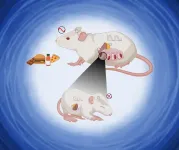(Press-News.org) The Sun’s differential rotation pattern has puzzled scientists for decades: while the poles rotate with a period of approximately 34 days, mid-latitudes rotate faster and the equatorial region requires only approximately 24 days for a full rotation. In addition, in past years advances in helioseismology, i.e. probing the solar interior with the help of solar acoustic waves, have established that this rotational profile is nearly constant throughout the entire convection zone. This layer of the Sun stretches from a depth of approximately 200 000 kilometers to the visible solar surface and is home to violent upheavals of hot plasma which play a crucial role in driving solar magnetism and activity.
While theoretical models have long postulated a slight temperature difference between solar poles and equator to maintain the Sun’s rotational pattern, it has proven notoriously difficult to measure. After all, observations have to “look through” the background of the Sun’s deep interior which measures up to million degrees in temperature. However, as the researchers from MPS show, it is now possible to determine the temperature difference from the observations of the long-period oscillations of the Sun.
In their analysis of observational data obtained by the Helioseismic and Magnetic Imager (HMI) onboard NASA’s Solar Dynamics Observatory from 2017 to 2021, the scientists turned to global solar oscillations with long periods that can be discerned as swirling motions at the solar surface. Scientists from MPS reported their discovery of these inertial oscillations three years ago. Among these observed modes, the high-latitude modes with velocities of up to 70 km per hour, proved to be especially influential.
To study the nonlinear nature of these high-latitude oscillations, a set of three-dimensional numerical simulations was conducted. In their simulations, the high-latitude oscillations carry heat from the solar poles to the equator, which limits the temperature difference between the Sun’s poles and the equator to less than seven degrees. “This very small temperature difference between the poles and the equator controls the angular momentum balance in the Sun and thus is an important feedback mechanism for the Sun’s global dynamics” says MPS Director Prof. Dr. Laurent Gizon.
In their simulations, the researchers for the first time described the crucial processes in a fully three-dimensional model. Former endeavors had been limited to two-dimensional approaches that assumed the symmetry about the Sun’s rotation axis. “Matching the nonlinear simulations to the observations allowed us to understand the physics of the long-period oscillations and their role in controlling the Sun’s differential rotation”, says MPS postdoc and the lead author of the study, Dr. Yuto Bekki.
The solar high-latitude oscillations are driven by a temperature gradient in a similar way to extratropical cyclones on the Earth. The physics is similar, though the details are different: “In the Sun, the solar pole is about seven degrees hotter than equator and this is enough to drive flows of about 70 kilometers per hour over a large fraction of the Sun. The process is somewhat similar to the driving of cyclones”, says MPS scientist Dr. Robert Cameron.
Probing the physics of the Sun’s deep interior is difficult. This study is important as it shows that the long-period oscillations of the Sun are not only useful probes of the solar interior, but that they play an active role in the way the Sun works. Future work, which will be carried out in the context of the ERC Synergy Grant WHOLESUN and the DFG Collaborative Research Center 1456 Mathematics of Experiments, will be aimed at better understanding the role of these oscillations and their diagnostic potential.
END
Long-period oscillations control the Sun’s differential rotation
High-latitude long-period oscillations provide a feedback mechanism that limits the Sun’s pole-to-equator differential rotation.
2024-03-27
ELSE PRESS RELEASES FROM THIS DATE:
A combination of approved drugs enhances the delivery of anti-bacterial medications to treat tuberculosis
2024-03-27
BOSTON – Tuberculosis (TB) is often overlooked in developed countries such as the United States, but this bacterial infection remains one of the deadliest diseases globally and results in millions of deaths annually.
Deaths can occur even with treatment, sometimes because of drug resistance in TB bacteria and other times due to poor delivery of TB-targeting drugs to patients’ infected lung tissue.
To address the latter challenge, a team led by researchers at Massachusetts General Hospital (MGH) in collaboration with scientists at the National Institute of Allergy and ...
Could AI play a role in locating damage to the brain after stroke?
2024-03-27
EMBARGOED FOR RELEASE UNTIL 4 P.M. ET, WEDNESDAY, MARCH 27, 2024
MINNEAPOLIS – Artificial intelligence (AI) may serve as a future tool for neurologists to help locate where in the brain a stroke occurred. In a new study, AI processed text from health histories and neurologic examinations to locate lesions in the brain. The study, which looked specifically at the large language model called generative pre-trained transformer 4 (GPT-4), is published in the March 27, 2024, online issue of Neurology® Clinical Practice, an official journal of the American Academy of Neurology.
A stroke can ...
High fat/low protein diets in rats during pregnancy and postnatally may cause altered glucose control and other "maladaptive" metabolic changes in their offspring
2024-03-27
High fat/low protein diets in rats during pregnancy and postnatally may cause altered glucose control and other "maladaptive" metabolic changes in their offspring
###
Article URL: https://journals.plos.org/plosone/article?id=10.1371/journal.pone.0299554
Article Title: Intrauterine and early-life malnutrition in rats disrupts the circadian rhythm programming of energy metabolites through adulthood
Author Countries: México
Funding: This research was partially supported by PD-LBAE-FC UNAM 2015-2019, DGAPA ...
Just 1 in 14 adults across 55 LMICs who have both hypertension and diabetes have both conditions under adequate control
2024-03-27
Just 1 in 14 adults across 55 LMICs who have both hypertension and diabetes have both conditions under adequate control, with only 20-30% of patients taking medications, indicating a lack of adequate healthcare in these settings.
======
Article URL: https://journals.plos.org/globalpublichealth/article?id=10.1371/journal.pgph.0003019
Article Title: Multiple cardiovascular risk factor care in 55 low- and middle-income countries: A cross-sectional analysis of nationally-representative, individual-level data from 280,783 adults
Author Countries: ...
Your emotional reaction to climate change may impact the policies you support
2024-03-27
Emotional reactions to climate change may lead to specific policy preferences, according to a study published March 27, 2024 in the open-access journal PLOS Climate by Teresa A. Myers of George Mason University and colleagues.
A politician, public speaker, or journalist may opt for an emotional appeal when communicating about climate change. Indeed, research shows that emotional investment can raise awareness of important issues and galvanize an otherwise apathetic public. However, existing research has not explored the unique links between specific ...
Persistent hiccups in a far-off galaxy draw astronomers to new black hole behavior
2024-03-27
At the heart of a far-off galaxy, a supermassive black hole appears to have had a case of the hiccups.
Astronomers from MIT, Italy, the Czech Republic, and elsewhere have found that a previously quiet black hole, which sits at the center of a galaxy about 800 million light years away, has suddenly erupted, giving off plumes of gas every 8.5 days before settling back to its normal, quiet state.
The periodic hiccups are a new behavior that has not been observed in black ...
Europe’s forgotten forests could be 21st century ‘biodiversity hot spots’
2024-03-27
An overlooked and long-neglected type of forest has vast capacity to rebound, enhancing species diversity and resilience to climate change, according to an international team of forest scientists.
According to new research, published today in the peer-reviewed science journal PLOS ONE, there is ample habitat for the Eurasian aspen, and these environments will continue to be suitable for this “keystone species” as the global climate warms.
“The Eurasian aspen, and aspen species globally, are home to vast populations of other dependent plants and animals,” said the study’s lead author, Antonin Kusbach, an applied ecologist at Mendel University in ...
Combining epigenetic cancer medications may have benefit for colorectal cancers and other tumor types
2024-03-27
GRAND RAPIDS, Mich. (March 27, 2024) — A pair of medications that make malignant cells act as if they have a virus could hold new promise for treating colorectal cancers and other solid tumors, reports a study published today in Science Advances.
The preclinical research, led by Van Andel Institute scientists, determined how low doses of a DNMT inhibitor sensitize cancer cells to an EZH2 inhibitor, resulting in a one-two punch that combats cancer cells better than either drug alone.
The findings are the foundation for an upcoming Phase I clinical trial to evaluate this combination ...
Reevaluating an approach to functional brain imaging
2024-03-27
A new way of imaging the brain with magnetic resonance imaging (MRI) does not directly detect neural activity as originally reported, according to scientists at MIT’s McGovern Institute. The method, first described in 2022, generated excitement within the neuroscience community as a potentially transformative approach. But a study from the lab of McGovern associate investigator Alan Jasanoff, reported March 27, 2024, in the journal Science Advances, demonstrates that MRI signals produced by the new method are generated in large part by the imaging process itself, ...
Food matters: Healthy diets increase the economic and physical feasibility of 1.5°C
2024-03-27
“We find that a more sustainable, flexitarian diet increases the feasibility of the Paris Agreement climate goals in different ways,” says Florian Humpenöder, PIK scientist and co-lead author of the study to be published in Science Advances. “The reduction of greenhouse gas emissions related to dietary shifts, especially methane from ruminant animals raised for their meat and milk, would allow us to extend our current global CO2 budget of 500 gigatons by 125 gigatons and still stay within the limits of 1.5°C with a 50 percent chance,” he adds.
Putting a price on greenhouse gas (GHG) emissions ...
LAST 30 PRESS RELEASES:
New software sheds light on cancer’s hidden genetic networks
UT Health San Antonio awarded $3 million in CPRIT grants to bolster cancer research and prevention efforts in South Texas
Third symposium spotlights global challenge of new contaminants in China’s fight against pollution
From straw to soil harmony: International team reveals how biochar supercharges carbon-smart farming
Myeloma: How AI is redrawing the map of cancer care
Manhattan E. Charurat, Ph.D., MHS invested as the Homer and Martha Gudelsky Distinguished Professor in Medicine at the University of Maryland School of Medicine
Insilico Medicine’s Pharma.AI Q4 Winter Launch Recap: Revolutionizing drug discovery with cutting-edge AI innovations, accelerating the path to pharmaceutical superintelligence
Nanoplastics have diet-dependent impacts on digestive system health
Brain neuron death occurs throughout life and increases with age, a natural human protein drug may halt neuron death in Alzheimer’s disease
SPIE and CLP announce the recipients of the 2025 Advanced Photonics Young Innovator Award
Lessons from the Caldor Fire’s Christmas Valley ‘Miracle’
Ant societies rose by trading individual protection for collective power
Research reveals how ancient viral DNA shapes early embryonic development
A molecular gatekeeper that controls protein synthesis
New ‘cloaking device’ concept to shield sensitive tech from magnetic fields
Researchers show impact of mountain building and climate change on alpine biodiversity
Study models the transition from Neanderthals to modern humans in Europe
University of Phoenix College of Doctoral Studies releases white paper on AI-driven skilling to reduce burnout and restore worker autonomy
AIs fail at the game of visual “telephone”
The levers for a sustainable food system
Potential changes in US homelessness by ending federal support for housing first programs
Vulnerability of large language models to prompt injection when providing medical advice
Researchers develop new system for high-energy-density, long-life, multi-electron transfer bromine-based flow batteries
Ending federal support for housing first programs could increase U.S. homelessness by 5% in one year, new JAMA study finds
New research uncovers molecular ‘safety switch’ shielding cancers from immune attack
Bacteria resisting viral infection can still sink carbon to ocean floor
Younger biological age may increase depression risk in older women during COVID-19
Bharat Innovates 2026 National Basecamp Showcases India’s Most Promising Deep-Tech Ventures
Here’s what determines whether your income level rises or falls
SCIE indexation achievement: Celebrate with Space: Science & Technology
[Press-News.org] Long-period oscillations control the Sun’s differential rotationHigh-latitude long-period oscillations provide a feedback mechanism that limits the Sun’s pole-to-equator differential rotation.



